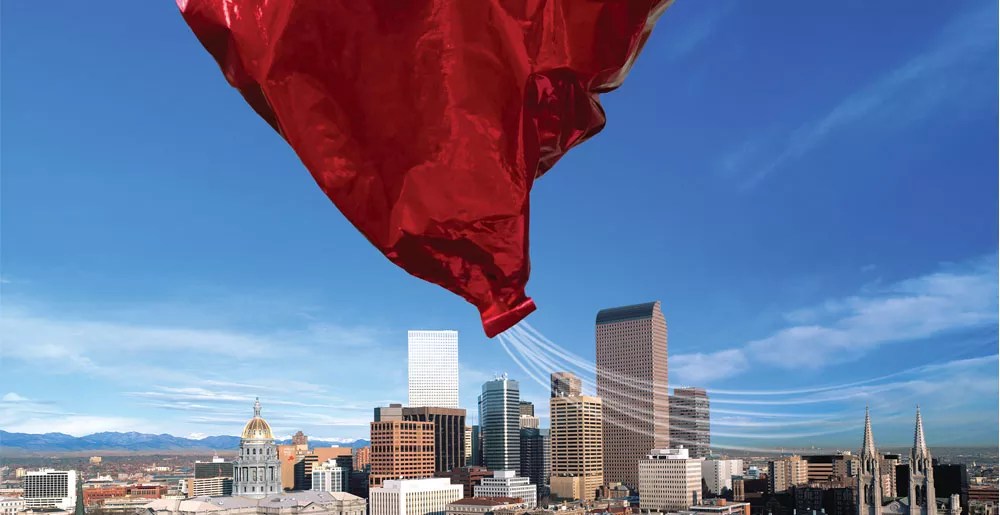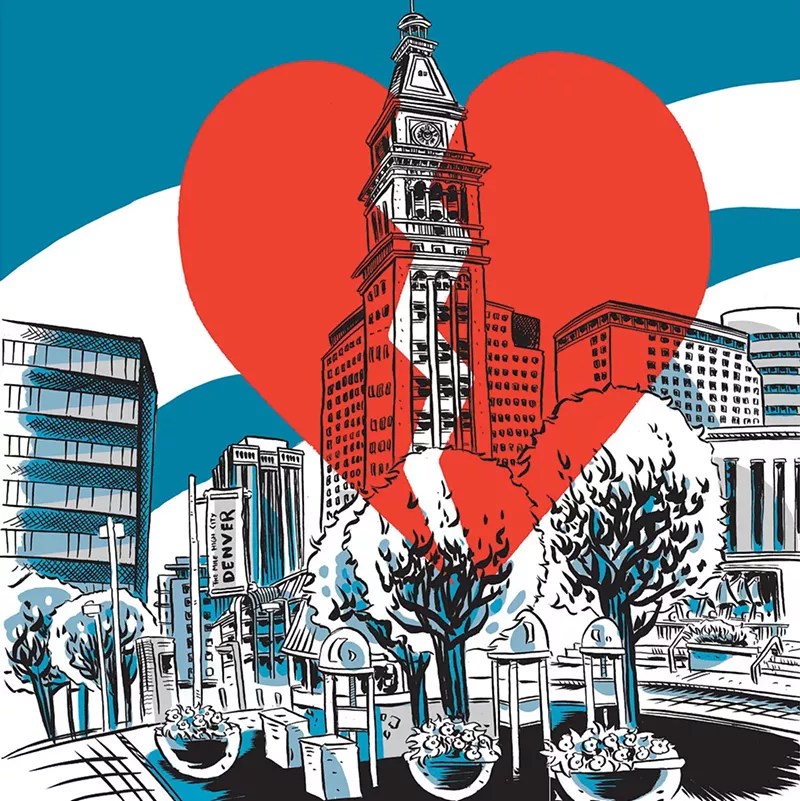
Photo Illustration by Monika Swiderski

Audio By Carbonatix
On Monday, July 21, Mayor Mike Johnston will offer his annual State of the City speech.
In the meantime, I have one word for the current state of the Mile High City: deflated.
It’s not because the pace of people moving here has slowed lately (although a few media outlets have been trumpeting that stat like prophets of doom); this is nothing like the late ’80s, when more moving vans left Colorado than pulled in. People are still coming to Colorado; they’re just not coming as fast as they used to. And wasn’t that something we prayed for in the boom years, when we cursed all that traffic (particularly as we tried to head to the mountains on Friday afternoon) and the wait for reservations at Denver’s increasingly impressive restaurants and transplants in general?
This isn’t even like July 2022, when Denver (and just about everywhere else) was still so down two years into the pandemic that I wondered if Denver had lost its mojo. Had our Rocky Mountain High flatlined?
Denver, make your New Year’s Resolution Count!
We’re $17,500 away from our End-of-Year campaign goal, with just a five days left! We’re ready to deliver — but we need the resources to do it right. If Westword matters to you, please contribute today to help us expand our current events coverage when it’s needed most.
And this isn’t like the summer of 2023, either, when Johnston’s election over sixteen other candidates seemed to promise that Denver would rise again, that this city was on the move…somewhere.
Now, with big budget cuts looming, Denver’s spirits are again deflated.
This past winter, I suggested ten things that Johnston could do to bring back downtown. It was still suffering from the battering of COVID, homelessness and the influx of migrants that had added to the challenges of ending unsheltered homelessness, a promise he’d made when he ran for mayor. And then, in January, with the encampments cleared and things looking up, there were the stabbings on the still-uncompleted 16th Street Mall. It was enough to break the heart of Denver.
A trial balloon
Now, as we head to the halfway mark for Johnston’s first term as mayor, I have a progress report on those ten items, as well as this new trial balloon:
Downtown needs its workers to come back now, and who better to start with than the people employed by the City and County of Denver? City workers are about to suffer through furloughs and layoffs dire enough that the Career Service Board recently approved a variation on the firing formula that diminishes the value of seniority (and, not incidentally, institutional memory). Before the city starts using that formula, how about making working in those downtown city offices every day a requirement? Those who want to stay home can…they just won’t have a job.
I’m not the first person to suggest this; a few downtown business owners suffering from the lack of foot traffic came up with the idea of putting a measure requiring in-office work for city workers on the Denver ballot – maybe even for state workers on the Colorado ballot. Since employees of the city and the state comprise the two largest components of downtown office workers, that could be a fast fix.
Proponents of the concept were discouraged by cost estimates for getting it on the ballot. But can we afford not to make this move? If the mayor and governor could let people work at home during the pandemic, why can’t they order them back in order to cure another ill?
Trial balloon launched. Now, back to my original list, rearranged by reality.

Karl Christian Krumpholz
Rising to the occasion
1) Get the job done on the 16th Street Mall. This one is close, although there were still plenty of roadblocks along the way when the official celebration welcomed summer. While the timetable for completion in late fall looks solid, no one has ever given a really good answer for why the entire project took so long. But then, no one has ever given a solid explanation of why it cost $100,000 to come up with the mall’s new/old name: 16th Street. (The answer is actually simple: the name was part of a larger public feedback process, and $100,000 isn’t an unreasonable amount for that. A tougher question: Why did the contract go to a London firm?)
2) Bring back the Mounted Patrol Unit. Denver didn’t horse around on this one. Even before the attack on the mall in January, the city was working with downtown residents and businesses on new ways to deploy the Denver Police Department to keep the area safe. And within days of my list being published, Denver’s Mounted Patrol Unit was back on the beat, too.
3) Help restaurants all over town, but especially downtown. Yes, help is at hand! Visit Denver, the city’s tourism/convention arm (which is marking a record year for convention business – take that, prophets of doom), has stepped in to create a position for a restaurant czar to work as a liaison with the city. Or make that czars: We hear a contract is in place, and a trio of experienced restaurateurs will be working together to make the city more hospitable to the hospitality industry. I’d suggested this position be part of the Department of Community Planning & Development, but given the budget crunch, this is a better solution: The czars have opened restaurants, they’ve run restaurants, and they know just what a pain the city’s permitting process can be. (Note: While you can expect the czars to come out swinging, that’s no guarantee that Denver City Council will accept the compromise invitation proffered last session by the Colorado Legislature, which allows municipalities to come up with their own plans for balancing the tipped minimum wage with the standard minimum wage.)
4) Subsidize live music on Thursday nights. Taking a page from Tami Door, the former head of the Downtown Denver Partnership, I suggested that the Partnership, which is charged with activating 16th Street, pay for a band at every venue along 16th that wants to host one on a Thursday night, creating a scene. Instead, the Partnership is paying for live bands at lunch every weekday at 16th and Glenarm (too bad those government workers aren’t running down to listen on their lunch hour) as well as some evenings and weekends.
5) Tout noteworthy downtown events on social media every day. Well, the Galleria full of barbershop singers looked pretty impressive. But the city could do much more to get the word out.
Falling flat
6) Hire a Night Mayor. As the 2023 mayoral campaign wrapped up, some nightlife fans pushed for the city to appoint a Night Mayor, a person who would focus on the unique needs of the nighttime economy of bars, clubs, restaurants and other entertainment outlets. The restaurant czars are a start, but the bars and music venues could really use help, especially at let-out, when crowds flood the street…and often land in trouble.
7) The Mile High Mile. If and when 16th Street is finally completed, why not celebrate by hosting the Mile High Mile, a run along a mile-long stretch through the heart of downtown? So far there’s been no movement on this, but maybe it could become part of the Outside Festival.
8) Postpone the Civic Center Park project. And speaking of the Outside Festival, where will it be next year? Not in Civic Center, unless Denver comes to its senses and postpones the planned closure of the park for renovations. First local businesses suffered through the mess on 16th, now they’re being killed by the Bus Rapid Transit construction on Colfax. We don’t need Civic Center Park to be a mess, too, not when the Centennial State will be turning 150 in 2026. Postpone that project and let its residents celebrate in the heart of Colorado’s capital city. (Governor Jared Polis is currently polling the people on plans for that awful Colorado 150 Pedestrian Walkway; unless the fix is in, we won’t have to worry about that bridge adding to the construction nightmare.)
9) Story time. In honor of that anniversary, I suggested the city roll out 150 stories of remarkable people, places and things over the next year. Since city cutbacks will no doubt hit communications teams, too, I’m willing to give Denver a pass on this. In fact, Westword will take it on (more on that later).
10) Get the electronic ticker tape going again: Back in 2005, the city had two daily newspapers working under a joint operating agreement and sharing a just-completed, state-of-the-art building just off Broadway. Today, the Rocky Mountain News is dead, the Denver Post is owned by a hedge-fund vulture that’s moved its offices to its printing plant, and last year, Denver bought the building to provide offices for city employees (when they aren’t working remotely, and while they still have jobs). I thought it would be a nice morale boost to get that electronic ticker tape on the side going again, displaying informative, entertaining, positive messages about Denver. I even volunteered to write them.
But as it turns out, this messenger is DOA. The system needs a reported million-dollar fix, and a cash-strapped city does not have that kind of money.
But I’ll still deliver my initial message: Denver can rise again.